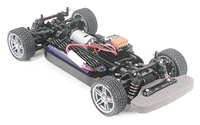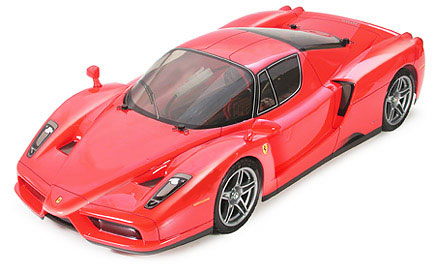Introducing
Remote Control (R/C) Cars
Welcome to the club page for remote control model FIATs. I started with
a Mad Bull – a sort of standard entry level, easy to build, drives
anywhere, but limited tuning.
My latest project is an Enzo
Ferrari from TAMIYA and I'd like to talk about that.
Project Enzo
I run my cars at our school r/c club. We aren’t allowed to use
any fuel, so electric is the driving force!
I chose a 1/10th scale Enzo
Ferrari because its battery sits parallel to the rear drive shaft –
with better balance and handling. Like all these models its also 4-wheel
drive. Its body is plastic and strong (although pricey at over £45.)
Aluminum and carbonfibre options are available too but cost more. The
chassis was easy to assemble.
This wouldn’t be my first choice of Ferrari, but Tamiya make it
in standard (TT-01) and race (TB-02) forms.
TB-02 comes with race shocks
and ball race bearings. It’s cheaper to buy this package than
upgrade later, if you can afford it all at once.
The Enzo body comes as clear plastic to spray inside, masking out the
clear windows first. I couldn’t find the Tamiya colour I wanted
– Ferrari Sunburst Yellow. So I used Fiat Broom Yellow with a
white primer behind. Problem is it tends to flake off on heavy impact.
We are going to try protecting it with a lacquer coat inside.
I liked blue window tints and found a stop light spray by Folia Tec
from Halfords. Works well – lots of thin coats needed.



Tips
from my Enzo Build
Here are some tips from my
build:
Tip 1 To cure the paint-flake problem I’ll use
the recommended polypro paints that stick to the shell and resist impact
shocks better. Even if they don't look so cool.
Tip 2 Unless you want a stone dredger/ road sweeper,
do not cut off the body mounting posts as Tamiya show on their build
manual photos (see above). You need to be able to change the ride height
of the body!
Tip 3 If you keep loosing the pins to hold the body
on the posts try paper clips they’re cheaper.
Tip 4 Check
out the HPI body shells at half Tamiya prices.
Driving the Enzo
The Enzo is highly nervous in cornering - but at the right times - so
you can flick it easily. I set it up like this, but you could just as
easily set it to a different driving style.
My way it needs quicker opposite lock reactions but it also corners
faster.
Our club meets after school every other Thursday. We use a small car
park at the back of the school. It’s mostly enclosed with trees
walls and shrubs to catch the cars when they get flicked into the air.
I won the last championship after a close fight with my main rival,
who races a highly tuned Subaru Impreza. He finished 2nd last season
behind my Mad Bull.
This year his Subaru is much
quicker. In third is a Toyota Supra which is the quickest down the straights
- not as good cornering. All three are on Tamiya chassis.
There are 9 more in the field
but they’re not as quick. Newest arrival is a Lotus Exige with
a shell from HPI. They cost about half of the Tamiya shells and are
worth checking out. I’m thinking of joining the nearest R/C club
at Aldershot too but it’s a long way to travel.
Enzo - Likes & Dislikes
I like the chassis rigidity.. its flickability…balance, weight
distribution and steering accuracy. Also has good wheelbase size.
I don’t like the easy way it collects stones from the tyres inside,
the vent hole under the motor (I blocked mine up) that badly clogs up
your motor leading to frequent cleaning. I also dislike the rapid wearing
motor bushes, and its weak points: the plastic joints on the steering
arms (pop off on impact), plastic diff casing, and especially the nylon
drive gears (tend to get munched in competition). I replaced the drive
gears with aluminium ones as soon as I could. The Enzo wing mirrors
last about 2 seconds in competition.
Upgrades
With the next tuning parts the Enzo will be seriously modded. I’ve
bought a 9 twin turn motor, along with a matching electronic speed control
(ESC) and race slick tyres. A new motor will often need another compatible
ESC and they can be as expensive as the motor itself.





If you can’t afford this lot, I’d start with different grades
of spring and oil for the shock absorbers (try and choose shock absorbers
that are oil filled) or a decent speed control (ESC) that will liven
up even a standard motor. Springs should come in pairs with different
strengths (spring rates). And they should be colour coded to help in
testing/ swapping.
Look at the drive gear ratios too. To keep the wheelspin down you need
to know the surface and tyres you will use – how much grip there
is. And check if your car reaches its top speed before the corners in
races. Changing the final drive ratio will trade acceleration for top
speed (or top speed for acceleration). Look at when you want to overtake
other cars in your races too – I mean where your car is faster
or slower than theirs.
FAQs
How fast are they? Electric have near instant acceleration,
only limited by wheel spin. My Enzo does 40mph in about 1 second (again
depends on the wheel spin) and tops out at about 60. Nitro have a clutch
and gears and are probably slower off the mark, but tend to have better
top speeds - like 80mph.
Do I choose Nitro or Electric
Power?
First Nitro - Nitro fuelled
motors give more power and top speed, and better endurance. But it’s
more difficult to find places to run them. The fastest can reach 70-80
mph so are really only usable in wide-open spaces or on purpose built
club tracks. They may need catch fencing if/ when they fly and the public/spectators
need to be protected or zoned away from the high risk areas around corners.
Nitro fuel comes in 2 litre containers for around £30 (not in
gas bottles like the real cars, as dad thought!).
Tip 1 Choose a local club and find out what cars they
run in their championships etc. before you decide on the car & motor
to get if you’re going to race it. Then you’ll have advice
and fellow nuts on hand. For example Schumaker make some of the
quickest nitro models in the world, but the UK currently has only one
championship for them.
Tip 2 If
you're not going to race them, decide where you will be using it.
Then there's electric motors. They are cleaner but rely on heavier batteries
for power. Typical top speeds are from 15 to 60 mph – depending
on your motor and gearing - but have better torque and acceleration
as nitro cars have to deal with a clutch & gear changes.
How long do the batteries last? They’ll run for 5 –
25 minutes in races (constant running) depending on the battery size,
and motor tuning. And whether you keep the speed up and don’t
stop. Starting a tuned motor drains the battery a lot. I think swapping
over batteries is faster than re-fuelling nitros but then you have to
buy more than one battery!
What size are the models? 1/10th scale is a good compromise
– its stable over bumps outside, gives you a good chance to control
at high speed, is good for looks, yet still easy to carry and store.
It’s also popular and not as expensive as larger scales.
Indoors, in limited space,
smaller scales will be better….like 1/17th or 1/18th. Latest technology
has improved the 1/20th scales a lot if you only want to run them in
an indoor hall. They are all quick and cheaper than the 1/10th size.
What does it cost? For Electric set ups you’ll need a
car, car battery & charger, controller, control battery & charger.
In most cases the controller, batteries and chargers are not supplied
with the cars. They cost about £100 – £200 for the
cars, £20 for the batteries and £45 for the controller and
charger. Nitro engined cars are more expensive to buy and run. Try eBay
and similar sites for second hand too.
What are crystals? Crystals are the chips that set the frequency
your car transmits and receives. There are 2 crystals, one for the transmitter
and one for the receiver. If they don’t match you can't control
your car, and if a friend has the same frequency then the most powerful
transmitter/battery will control both cars. Before you can run with
others the frequencies have to be checked & changed if they conflict.
What’s the controller’s maximum range? The controller
on full battery will go for about half a mile, but very rarely is there
a half mile in which to use it – that’s probably too far
away too see anyway.
Finding Your Local Clubs? Ask your nearest r/c model shops, or
look in magazines like R/C Racer. Internet searches are not as reliable
– not all clubs have sites you can find - but you could try.
Do I have to build it myself? No, there are Ready to Race (RtR)
and Almost Ready to Race (ARtR) around too. Choice is more limited and
performance could be dented. Or you could also pay for someone to do
your body for you. I get my dad to help!
How much space to race? You’ll know quickly yourself,
two tennis courts - or a car park twenty car parking bay is about the
minimum for 1/10th scale running. Twice that size is about the smallest
for several cars at once.
Where do we race? Using any of these cars in the street is
not good. They will cause accidents because drivers don’t know
how quick they can go. I was trying a new motor in my Enzo in a Tesco
car park (after hours) at the same time as a Fiesta turbo and a motor
bike were having a short drag race. The Enzo beat them both! My Ferrari
does 40mph almost instantly and tops out about 60mph… and its
nothing like the quickest.
How do I measure up for a new body shell? Just because you have
a 1/10th-scale chassis doesn’t mean a 1/10th-scale shell will
always fit it. You need to know the distance between the front &
rear wheels (the wheelbase) and the width across the axles (the track)
on the chassis. In some chassis the wheelbase is adjustable. Lastly
the body is hung off four vertical ‘posts’ – two posts
near the front and two near the rear of the chassis.
Reminder Don't
cut down the posts if you want to adjust the ride height later.
You need to make sure you can make holes in the new shell on its bonnet
& boot that line up with the posts, and look good with the body
at the right height. Best way is to take your chassis along and try
it out on the new shell. If you can’t do that then measure up
the old shell – its wheelbase, its track, and its front &
rear post positions (from the front and rear of the old shell AND the
chassis). Lastly don’t forget the foam that goes inside the front
of the shell to help take hits… some manufacturers supply it to
fit the shell, and some supply it with the chassis – either way
it needs to be shaped so it fits with no gaps.
Tip you can get ‘L’ shaped posts to change
their upright position if needed.
R/C Types available
We’re looking for Fiats and ‘derivatives’ like Lancia,
Alfa, Ferrari…etc
TAMIYA offer bodies for the Alfa Romeo 155 V6ti in Martini colours or
the Alfa Romeo 156 Racing
Kyosho offer the FIAT 500 on a Mantis W/GX12 chassis
(Officially discontinued April 2003)
Tamiya offer the Enzo Ferrari, F1 Ferrari and Modena 360 and a F50
I’ve seen a Dallara X1/9 too but don’t know who makes these
historics.
The search for Cool, Fast, R/C FIATs goes on!
Galleries – want to
show your r/c Italian car here? – Send some cool shots or reports
to me at randomspeedfreak@yahoo.co.uk
Page Links
Kyosho – www.kyosho.com and
for the FIAT 500 parts list (www.kyosho.com/parts/xr31841t.html)
ModelTech – spend some
serious wedge on custom builds! (www.modeltech.co.uk)
OnStat Computers – mini computers
for serious on-board data logging & analysis (www.onstat.com)
PROTRAK – offer battery
chargers (www.users.zetnet.co.uk)
Schumaker – Very quick, sophisticated nitro & electric good
chassis - pricey
TAMIYA – Easy to tune basic but reliable chassis. Tamiya Holland
has a good list of Body Parts (www.tamiya.ni/tamoptions/tam_53000_06.html)
and Wheels. (www.tamiya.ni/tamoptions/tam_53000_05.html)
try searching for the US version too.
YOKOMO (www.yokomo.com) bit cheaper
than Tamiya about the same quality.

